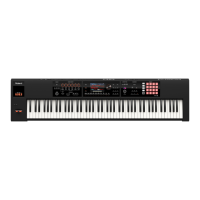EFFECTS EDIT
18
SYSTEM EFFECTS
1. Access the EFFECTS EDIT screen (p. 14).
2. Press the button for the system eect that you want to edit.
Button Explanation
[5] (Master EQ) Edits the equalizer that is applied to the entire sound engine of the FA.
[6] (TFX) Edits the TFX (total eect) settings.
[SHIFT] + [4] (Input)
Species the input volume from the AUDIO INPUT jack.
[SHIFT] + [5] (NS)
Edits the noise suppressor settings.
[SHIFT] + [6] (MIC Reverb)
Applies reverb to the microphone or other device that’s connected to the AUDIO INPUT jack.
The SYSTEM EFFECTS screen appears.
Parameter Value Explanation
Audio Input tab
Audio Input Level 0–127 Species the input volume of the device that is connected to the AUDIO INPUT jacks.
Audio Input Output Assign MAIN, SUB
Species the output destination of the sound that is input from the AUDIO INPUT jack.
MAIN: Output to the MAIN OUTPUT jacks.
SUB: Output to the SUB OUTPUT jack.
USB Audio tab
USB Audio Input Level 0–127 Species the input volume of the device that is connected to the USB COMPUTER port.
USB Audio Input Destination MAIN, SUB, TFX
Species the output destination of the sound that is input from the USB COMPUTER port.
MAIN: Output to the MAIN OUTPUT jacks.
SUB: Output to the SUB OUTPUT jack.
TFX: Output to a point before the total eect.
By setting TFX Location to “MAIN,” you can apply the total eect to the sound of the USB Audio
Input.
USB Audio Output Select MAIN, INPUT, INPUT-EFX
Species the USB audio sound that is output from the USB COMPUTER port.
MAIN: The same sound as the output from the MAIN OUTPUT jacks is output from the USB
COMPUTER port.
INPUT: The sound that is input from the AUDIO INPUT jack is output without change from the USB
COMPUTER port.
INPUT-EFX:
The sound that is input from the AUDIO INPUT jack is processed by the noise suppressor
(NS) and microphone reverb (MIC Reverb) and then output from the USB COMPUTER jack.
You can apply the total eect by setting TFX Location to “Input.”
Noise Suppressor tab
NS Sw
([2] (NS Sw) button)
OFF, ON Switches the noise suppressor on/o.
NS Threshold 0–127 Adjusts the volume at which noise suppression starts to be applied.
NS Release 0–127 Adjusts the time from when noise suppression starts until the volume reaches 0.
MIC Reverb tab
MIC Rev Sw
([2] (MIC Rev Sw) button)
OFF, ON Switches the reverb on/o.
Input Reverb Type
ROOM1, ROOM2, STAGE1, STAGE2,
HALL1, HALL2, DELAY, PAN-DELAY
Selects the type of reverb.
Input Reverb Time 0–127 Adjusts the decay length of the reverb sound.
Input Reverb Level 0–127 Adjusts the volume of the sound that has passed through reverb.

